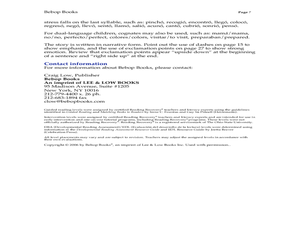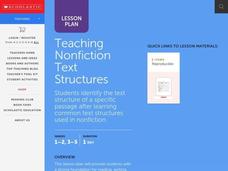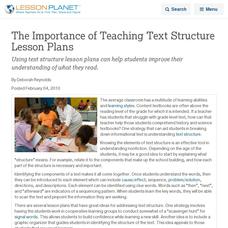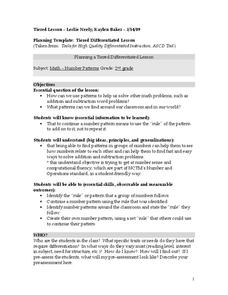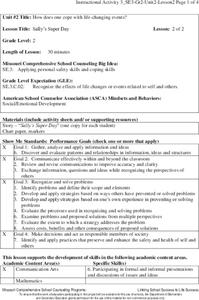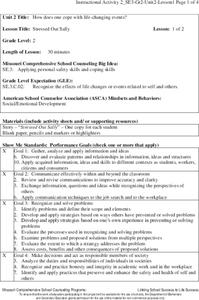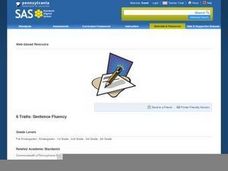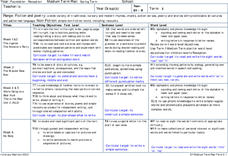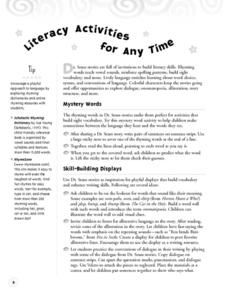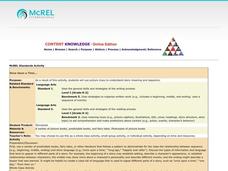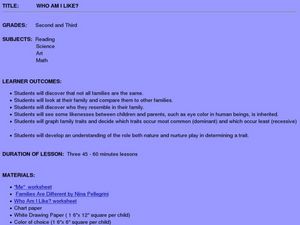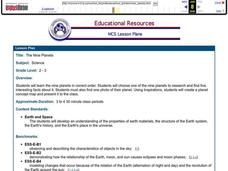Curated OER
Patterns in Nature
Students examine places in nature where patterns can be observed by looking through a number of books after watching a teacher PowerPoint presentation. They illustrate a pattern in nature.
Curated OER
Guided Reading with Elizabeti's Doll
Practice reading strategies using Elizabeti's Doll by Stephanie Stuve-Bodeen. Readers utilize decoding and comprehension strategies before, during, and after reading the story. A detailed list of text features, high frequency words,...
Curated OER
Five Quick Games Build Reading Skills
Build reading skills with these five quick games! Whether you're hoping to build grammar, syllabication, or word recognition skills, this resource has options for you. Kids will love taking a break from the mundane to play these...
Curated OER
Story Structure Slide Show
Analyzing the sequence of actions in dramatic stories leads to deeper comprehension of story structure. The class identifies the main actions in each section of a story and develops frozen tableau's for the identified actions of the...
Curated OER
Teach Text Structure for Nonfiction
Learners gain a strong foundation for reading, writing, and using nonfiction through this lesson. They gain an awareness and general understanding what text structures are. Students also identify and interpret what clues they can use...
Curated OER
The Importance of Teaching Text Structure Lesson Plans
Using text structure lesson plans can help students improve their understanding of what they read.
Curated OER
Teach Text Structure for Nonfiction
Students explore the patterns of text structure to anticipate the kind of information that a reading might present. The lesson examines some of the components of reading writing and using nonfiction.
Curated OER
Number Patterns
Second graders identify number patterns. In this number lesson, 2nd graders find the rule or pattern in a group of numbers and continue the pattern using the rule. They create their own number pattern by making their own rule.
Missouri Department of Elementary
Sally’s Super Day
After having a bad day, Sally took scholars' suggestions and had a super day. Pupils listen to her newest short story then discuss the events that occurred. They sort each event by what was in her control and what was not. Participants...
Missouri Department of Elementary
Stressed Out Sally
Life changes may cause stress. Here, scholars identify stressful situations in a peer's life and offer coping skills to make for a better day. A short story, "Stressed Out Sally," provides pupils with a look inside a bad day. After...
Pennsylvania Department of Education
6 Traits: Sentence Fluency
Students practice writing with sentence fluency in order to make the story more enjoyable for the reader. In this sentence fluency lesson plan, students focus on rhythm and flow.
Scholastic
Will He See His Shadow? Groundhog Day Activities
What a fantastic collection of activities for celebrating Groundhog Day! This resource includes a variety of holiday reading selections, groundhog facts, links to printables, story comprehension lessons, and much more!
Curated OER
Fiction and Poetry
Students explore fictional text and poetry. They explore the story structures used in the types of texts and examine the language patterns used. Students practice tracking text in the correct manner.
Scholastic
Literacy Activities for Any Time
As the title suggests, this packet is loaded with activities that can be used at any time. The common element in all the exercises is that they are connected to books by Dr. Seuss.
Curated OER
Once Upon a Time...
Model for emergent readers how to write a story by interpreting picture clues. For guided practice a second book is used, and then pupils work independently or with an adult to write their own stories based on illustrations.
Curated OER
I Went Walking Lesson Plan
Students study writing structure and patterns in repetitive texts. In this writing structure lesson, students read portions of a story and predict what will come next based on the repetitive text. Students create their own repetitive...
Pennsylvania Department of Education
6 Traits: Organization
Students make logical patterns in their writing to demonstrate the trait of organization. In this organization lesson plan, students focus on events proceeding logically.
Curated OER
Make a Snowflake
Students study the design of snowflakes. In this snow lesson, students discover the different shapes of a snowflake, and their similarities. Students study snowflakes outside, then create their own with popsicle sticks...
Curated OER
Sound It Out!
Help your class improve their spelling skills. Learners take a test, are given a particular spelling rule to practice, and play a Bingo game. This employs various methods for practicing spelling skills.
Curated OER
Who Am I Like?
Students examine family structures. In this family structure lesson, students discover things about their own families and those of their classmates. They make a chart as they discuss nature versus nurture, complete a worksheet about who...
University of Virginia
The Very Hungry Caterpillar
Young scholars engage in a activity that is concerned with the skill of reading comprehension while reading "The Very Hungry Caterpillar" as a class. They read the story while identifying the different types of food with the help of food...
Curated OER
Through the Eyes of the Big Bad Wolf
Imagine how the wolf would tell the tale of Little Red Riding Hood or The Three Little Pigs. Young writers re-imagine classic tales by adopting the point of view of another character in the story. After reading models like The True Story...
Curated OER
The Nine Planets
A solid instructional activity on teaching the nine planets in our solar system is here for you. In it, young scientists learn the correct order of the planets, and they choose one of the planets to do a research report on. They must...
Curated OER
Children's Literature Across the Curriculum Ideas-Two Eyes, A Nose, and A Mouth
Students read Two Eyes, A Nose, and A Mouth by Roberta Grobel Intrater. They complete a variety of cross-curricular activities surrounding faces and facial features. Included are reading, art, math, science, writing, social studies, and...

